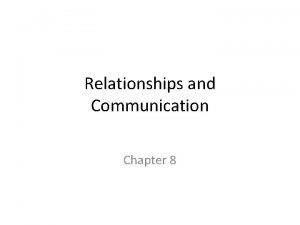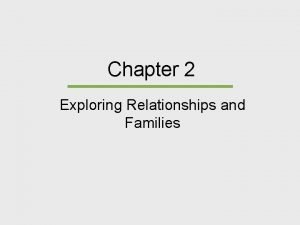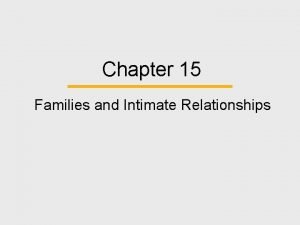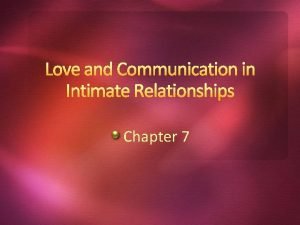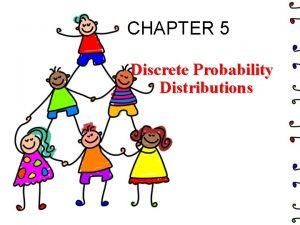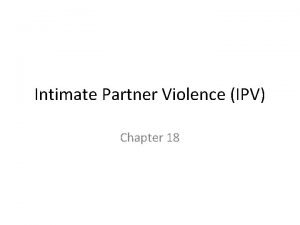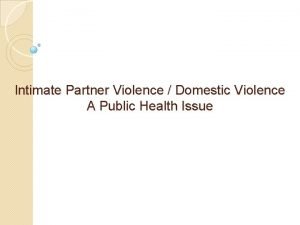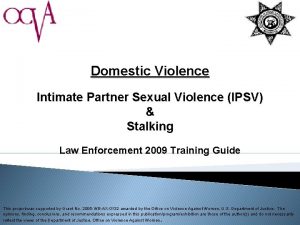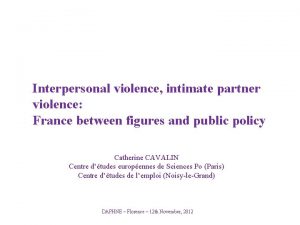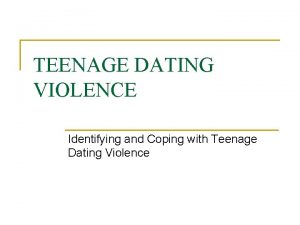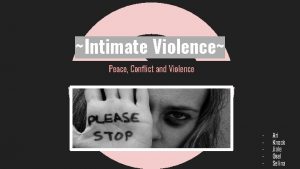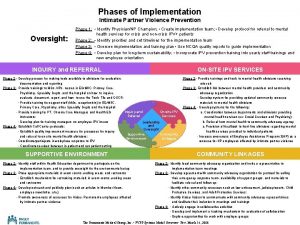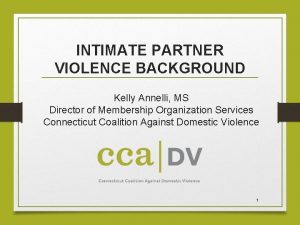Teenage Intimate Partner Violence some qualitative results from






















- Slides: 22

Teenage Intimate Partner Violence - some qualitative results from a European study Carolina Øverlien, Research professor at the Norwegian Center For Violence and Traumatic Stress Studies (NKVTS), Oslo, Norway

Safeguarding teenage intimate relationships (STIR) • EU-funded study of teenage intimate partner violence and abuse in five European countries • England – University of Bristol: Christine Barter, Nadia Agahtie, Marsha Wood; University of Central Lancashire: Nicky Stanley and Cath Larkins • Norway – The Norwegian Centre for Violence and Traumatic Stress Research (NKVTS): Per Hellevik, Carolina Överlien • Bulgaria – Applied Research and Communications Fund: Georgi Apostolov, Louisa Shahbazyan • Italy – CESIE: Noemi De Luca; University of Palermo: Gianna Cappello • Cyprus – Mediterranean Institute of Gender Studies: Stalo Lesta, Susana Pavlou • Survey: 4500 teenagers between the ages of 14 -17 • Interviews: 100 teenagers between the ages of 13 -19 • Funded by Daphne/EU (JUST/2011/DAP/AG/3330) • The Norwegian part of the study was also funded by the Ministry of Children and Families (BFD)

Definition “The physical, sexual, psychological, or emotional aggression within a dating relationship, including stalking. It can occur in person or electronically and might occur between a current or former dating partner. ” (CDC)

Definitions cont. • Teenage/Youth Intimate Partner Violence (and Abuse) • (Teen) Dating Violence - Physical violence - Psychological/emotional violence - Sexual violence - (Digital violence)

Young Women’s Experiences of Intimate Partner Violence – Narratives of Control, Terror, and Resistance Carolina Øverlien, Norwegian Center For Violence And Traumatic Stress Studies, Oslo, Norway, and Stockholm University, Stockholm, Sweden Per Hellevik, Norwegian Center For Violence And Traumatic Stress Studies, Oslo, Norway Sibel Korkmaz, Stockholm University, Stockholm, Sweden

Methods and data from two interconnected studies • Norwegian study (part of the STIR study) • 21 interviews w/ youth who had experienced IPV • Informants 15 -18 years old • 19 girls, 2 boys • Subjected to violence in a heterosexual relationships • Swedish study: • 18 interviews w/ youth who had experienced IPV • Informants 17 -23 years old • 16 girls, 2 boys • 1 girl and both boys subjected to violence in a same-sex relationship

• The aim is to further our understanding of the dynamics of YIPV by investigating the contextual, situational, and relational aspects • Looking across the data, we ask: what are the main expressions of IPV among young women? • Through analyzing the young women’s narratives • What meanings do the young women attribute to the violence? • What is the role of digital media in their victimization? • How can Johnson’s (2008; 1995) typology of violence be used to develop our understanding of the violence and abuse experienced by the young women?

Analysis • Thematic analysis (Braun & Clarke, 2006) - to find patterns in data • Narrative analysis (Bruner, 1990; Riessman, 2008) - to find depth: context, relationship, situation, meaning

The thematic analysis (Braun & Clarke, 2006) yielded six themes • • • Control Humiliation Fear Sexual coercion Secrecy Resistance

Control • Expecting her to prioritize him before family, friends, hobbies, and trips. • Demanding to know at all times whom she was with or talked to • Requiring her to be constantly available (physically, mentally, and sometimes also sexually) • Dictating what she could wear and eat, and her use of makeup • Putting marks (such as “hickies” or bite marks) on visible parts of her body • Forcing her to wear his clothes for the school photo • Restraining her from leaving, for example by threatening to take his own life (cf. Toscano, 2014)

Jennie, 18 years old He wanted to know what I was wearing every day, he wanted to know what I was doing all the time, when I got up, when I left home, when I got to school, when I had lunch, when I finished school, when I was on the bus on my way home, when I caught the train, when I got home, when I had dinner, if I had dinner, and when I went to bed. He wanted me to text him these things. “Now I am home. ” “Now I will sit down and eat. ” “Now I have eaten. ” And if I didn’t do that, he got really angry.

The amount and intensity of control differed between relationships. For some, the control was continuous and all-encompassing, while for others it was more related to specific contexts or situations. A recurring theme related to control concerned how digital media (such as Snapchat) was used to facilitate such behavior.

Sexual coersion • • Being pressured to have sex Being forced to perform sexual acts with others Being hit until “agreeing” to perform Being expected to be sexually available regardless of one’s own wishes Most often intertwined with other forms of violence.

Karen, 18 years old After we broke up for a while, I said okay, we can give it a try again, but that nothing [sexual] should happen, that I wanted the emotions to be in place first, and he said alright at first, but then he wondered how much longer, and I said that I wasn’t sure, and then he said that I never sacrificed anything for him, and then I said okay, fine, if I only had sex with him I would be allowed to leave and go home, and after we had sex I went to the bathroom to cry, because I really didn’t want to, but he just got so angry, and had such low self-esteem, he thought I didn’t want to have sex with him because he was ugly, for gaining weight, for not being tanned enough, it was not enough to say “hey, I don’t feel like it, I’m not ready.

A matter of ‘gray zone sex’? (Cahill, 2014; 2016) • Persistent control of her throughout the relationship • If she says ‘no’ he would never leave her alone and would always find her (is consent possible in abusive relationships? ) • Narrative told as a response to the question “Did he ever put any sexual pressure on you? ” • Low agency – ‘unjust sex’ (Cahill, 2014; 2016) • Some young women seem to have the understanding that, in a relationship, women have a duty to have sex and to be bodily available at all times (cf. Aghtaie et al. , 2018; Davies, 2019).

Michaela, 17 years old I took a bucket or something and went to his bedroom, and sat on the bed with the bucket in front of me, and felt really sick, and then a friend came in and asked how I was doing. In retrospect I wish I had asked her to stay, because then nothing would have happened—it is easy to be smart when it is all over. I said I felt ill but that I was okay, so she went out and he came in and lay behind me in bed, and then, well, I sat there with the bucket and was nauseous, but still he thought that was a great time to abuse me [said ironically], he tried to get me down on the bed, and I said “no, I don’t feel well, ” was about to throw up, but still he just kept going, and finally he got me down and I gave up resisting, so then he had intercourse with me.

The sexual coercion in needs to be understood in the context of age, gender and relation (Kelly, 1988). He is: • • • Significantly older Physically stronger More experienced in regards to sex and alcohol Has his own apartment She defines him as her boyfriend (want to explain, don’t want to upset him)

Resistance Parallel to any narrative of victimization is a narrative of resistance (Cavanagh, 2003; Hydén, 2005; Wade, 1997). Hence, in order to tell (more of) the whole story, we need to include the stories of how victims of violence also resist violence.

Lene, 18 years old I was at his house, because he was with his father…and he got pissed off because I didn’t want to kiss him, so he got pissed off and we started fighting and it ended up with him holding me down, I wanted to get away, but he locked me into a room and I wasn’t allowed out, I tried to break free but he held me and threatened me with his fist…I asked him to let me go, but he didn’t, my god my breathing was so heavy… I still have a recording of it on my phone. Interviewer: You have a recording of it? Lene: Yes. Interviewer: And how did you do that? Lene: I just wanted proof that he was not alright. Interviewer: And when he holds you down you reach for your phone. Lene: Yes, and I put it in my bra. Interviewer: You put it in your bra. Lene: Yes, to record it.

What meanings do the young women attribute to the violence? • It is a matter of age (“we were young and childish”) • It was meant to purposely hurt and destroy • Attributing it to the male partner’s personal issues (he had a “meltdown”, is mentally unstable, has had a difficult childhood) • Blaming it on her own behavior or appearance • Thinking that his behavior lacked meaning (feeling confused and seeing no reason for the abuse).

Impact - Increased attention in policy and practice • TIPV and the STIR study included in reports from Norwegian NGO’s • Given the large interest from our government - TIPV included in the next action plan? • STIR in numerous media articles • STIR used to get funding for a new hotline in Sweden (1000 opportunities) specifically and exclusively for young people (victims and perpetrators of IPV) • Lots of interest from the practice field (digital violence)!

Thank you!
 The spyware used in intimate partner violence
The spyware used in intimate partner violence Results and discussion in research example
Results and discussion in research example Define the relationship chapter 7
Define the relationship chapter 7 Relationship guidelines chapter 8
Relationship guidelines chapter 8 Intimate family chapter 2
Intimate family chapter 2 Intimate zone in communication
Intimate zone in communication Intimate family chapter 6
Intimate family chapter 6 The impact of incarceration on intimate relationships
The impact of incarceration on intimate relationships Intimate relationships, marriages, and families 9th edition
Intimate relationships, marriages, and families 9th edition Define the relationship chapter 7
Define the relationship chapter 7 Intimate zone in communication
Intimate zone in communication Intimate family chapter 6
Intimate family chapter 6 Intimate language register
Intimate language register Intimate distance examples
Intimate distance examples 01 me line intimate
01 me line intimate Relaxed antonym
Relaxed antonym The essence of marriage chapter 2
The essence of marriage chapter 2 Dewgarden foaming intimate wash benefits
Dewgarden foaming intimate wash benefits Causes of teenage pregnancy
Causes of teenage pregnancy Teenage alcohol consumption
Teenage alcohol consumption Chapter 5 discrete probability distributions
Chapter 5 discrete probability distributions Frontline inside the teenage brain
Frontline inside the teenage brain Nursing theories related to teenage pregnancy
Nursing theories related to teenage pregnancy



